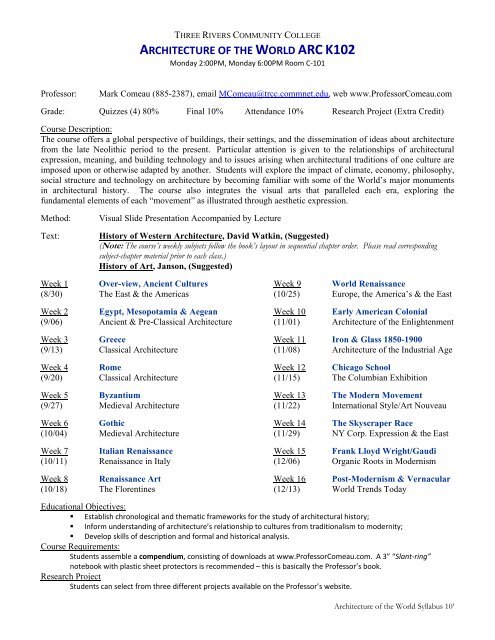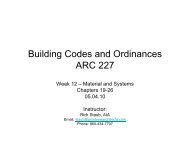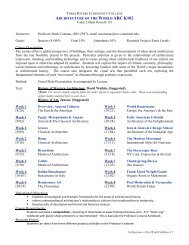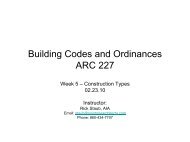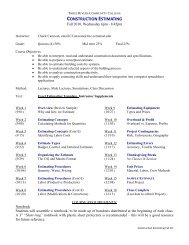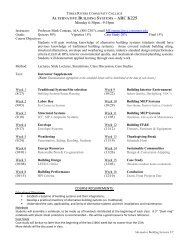architecture of the world arc k102 - Architectural Design Program
architecture of the world arc k102 - Architectural Design Program
architecture of the world arc k102 - Architectural Design Program
Create successful ePaper yourself
Turn your PDF publications into a flip-book with our unique Google optimized e-Paper software.
THREE RIVERS COMMUNITY COLLEGEARCHITECTURE OF THE WORLD ARC K102Monday 2:00PM, Monday 6:00PM Room C‐101Pr<strong>of</strong>essor:Mark Comeau (885-2387), email MComeau@trcc.commnet.edu, web www.Pr<strong>of</strong>essorComeau.comGrade: Quizzes (4) 80% Final 10% Attendance 10% Rese<strong>arc</strong>h Project (Extra Credit)Course Description:The course <strong>of</strong>fers a global perspective <strong>of</strong> buildings, <strong>the</strong>ir settings, and <strong>the</strong> dissemination <strong>of</strong> ideas about <strong><strong>arc</strong>hitecture</strong>from <strong>the</strong> late Neolithic period to <strong>the</strong> present. Particular attention is given to <strong>the</strong> relationships <strong>of</strong> <strong>arc</strong>hitecturalexpression, meaning, and building technology and to issues arising when <strong>arc</strong>hitectural traditions <strong>of</strong> one culture areimposed upon or o<strong>the</strong>rwise adapted by ano<strong>the</strong>r. Students will explore <strong>the</strong> impact <strong>of</strong> climate, economy, philosophy,social structure and technology on <strong><strong>arc</strong>hitecture</strong> by becoming familiar with some <strong>of</strong> <strong>the</strong> World’s major monumentsin <strong>arc</strong>hitectural history. The course also integrates <strong>the</strong> visual arts that paralleled each era, exploring <strong>the</strong>fundamental elements <strong>of</strong> each “movement” as illustrated through aes<strong>the</strong>tic expression.Method:Text:Visual Slide Presentation Accompanied by LectureHistory <strong>of</strong> Western Architecture, David Watkin, (Suggested)(Note: The course’s weekly subjects follow <strong>the</strong> book’s layout in sequential chapter order. Please read correspondingsubject-chapter material prior to each class.)History <strong>of</strong> Art, Janson, (Suggested)Week 1 Over-view, Ancient Cultures Week 9 World Renaissance(8/30) The East & <strong>the</strong> Americas (10/25) Europe, <strong>the</strong> America’s & <strong>the</strong> EastWeek 2 Egypt, Mesopotamia & Aegean Week 10 Early American Colonial(9/06) Ancient & Pre-Classical Architecture (11/01) Architecture <strong>of</strong> <strong>the</strong> EnlightenmentWeek 3 Greece Week 11 Iron & Glass 1850-1900(9/13) Classical Architecture (11/08) Architecture <strong>of</strong> <strong>the</strong> Industrial AgeWeek 4 Rome Week 12 Chicago School(9/20) Classical Architecture (11/15) The Columbian ExhibitionWeek 5 Byzantium Week 13 The Modern Movement(9/27) Medieval Architecture (11/22) International Style/Art NouveauWeek 6 Gothic Week 14 The Skyscraper Race(10/04) Medieval Architecture (11/29) NY Corp. Expression & <strong>the</strong> EastWeek 7 Italian Renaissance Week 15 Frank Lloyd Wright/Gaudi(10/11) Renaissance in Italy (12/06) Organic Roots in ModernismWeek 8 Renaissance Art Week 16 Post-Modernism & Vernacular(10/18) The Florentines (12/13) World Trends TodayEducational Objectives:• Establish chronological and <strong>the</strong>matic frameworks for <strong>the</strong> study <strong>of</strong> <strong>arc</strong>hitectural history;• Inform understanding <strong>of</strong> <strong><strong>arc</strong>hitecture</strong>’s relationship to cultures from traditionalism to modernity;• Develop skills <strong>of</strong> description and formal and historical analysis.Course Requirements:Students assemble a compendium, consisting <strong>of</strong> downloads at www.Pr<strong>of</strong>essorComeau.com. A 3” “Slant‐ring”notebook with plastic sheet protectors is recommended – this is basically <strong>the</strong> Pr<strong>of</strong>essor’s book.Rese<strong>arc</strong>h ProjectStudents can select from three different projects available on <strong>the</strong> Pr<strong>of</strong>essor’s website.Architecture <strong>of</strong> <strong>the</strong> World Syllabus 10’
EXPANDED COURSE OVERVIEWArchitecture <strong>of</strong> <strong>the</strong> World is an informative and intense course. Considerable content will beconveyed to <strong>the</strong> student while building a logical basis for understanding <strong>the</strong> designphilosophies and conditions which shaped <strong><strong>arc</strong>hitecture</strong> from pre-history to <strong>the</strong> present.The course is divided into (four) 4 week sections:The first section examines <strong>the</strong> origins <strong>of</strong> ancient-<strong>world</strong> <strong><strong>arc</strong>hitecture</strong> with specific focus on <strong>the</strong>cultures <strong>of</strong> Egypt, Mesopotamia and <strong>the</strong> Aegean. Differences in climate, geography, materials,philosophy, social structure and technology will be explored to discover how <strong>the</strong>se arereflected in <strong>the</strong> <strong><strong>arc</strong>hitecture</strong> <strong>of</strong> each culture.This section will also explore <strong>the</strong> classical <strong><strong>arc</strong>hitecture</strong> <strong>of</strong> Ancient Greece and Rome, asstudents are introduced to: <strong>the</strong> principles <strong>of</strong> <strong>the</strong> <strong>Architectural</strong> Orders and <strong>the</strong> elements <strong>of</strong>which <strong>the</strong>y are composed; detailing; engineering advances; proportion, and planning <strong>the</strong>ories.Christian Architecture will be traced from its origins in Rome through <strong>the</strong> syn<strong>the</strong>sis <strong>of</strong> form,function, philosophy and structure in <strong>the</strong> Gothic Ca<strong>the</strong>drals.The second section examines <strong>the</strong> origins <strong>of</strong> <strong>the</strong> Renaissance in Italy and <strong>the</strong> development <strong>of</strong><strong>the</strong> various Renaissance styles from Early Renaissance through <strong>the</strong> Baroque Period. Theeconomic, political, social and technical influences which shaped this movement will beexplored to provide a better understanding <strong>of</strong> <strong>the</strong> meaning <strong>of</strong> <strong>the</strong> forms used.This section will also explore <strong>the</strong> spread <strong>of</strong> Renaissance ideas and designs throughout Europe,<strong>the</strong> Americas and <strong>the</strong> East. Particular attention will be placed on <strong>the</strong> development <strong>of</strong>Renaissance design in France and England.The development <strong>of</strong> <strong><strong>arc</strong>hitecture</strong> in America will be traced from <strong>the</strong> Colonial Period through<strong>the</strong> Gothic Revival. Students will explore <strong>the</strong> relationship <strong>of</strong> American <strong><strong>arc</strong>hitecture</strong> to culturaldevelopments in Europe as well as <strong>the</strong> se<strong>arc</strong>h for an appropriate American style.The third section examines how society in general and <strong><strong>arc</strong>hitecture</strong> in particular, reacted to <strong>the</strong>changes and technology brought about by <strong>the</strong> Industrial Revolution. Students will exploreinitial reactions as <strong>the</strong>y found <strong>the</strong>ir expressions in <strong><strong>arc</strong>hitecture</strong>, a period covering <strong>the</strong> yearsroughly between 1850c and 1900c.This section will also examine <strong>the</strong> period covering 1900c to World War I as <strong>arc</strong>hitecturalresponse was refined in a se<strong>arc</strong>h to express <strong>the</strong> new century. The period covering World WarI to World War II is <strong>the</strong> final portion <strong>of</strong> this section to be explored as students discover how<strong>the</strong> war graphically demonstrated <strong>the</strong> immense power <strong>of</strong> technology for both construction anddestruction, thus, causing a general reassessment <strong>of</strong> values in society, <strong><strong>arc</strong>hitecture</strong> and design.The fourth and final section examines <strong>the</strong> period from World War II to <strong>the</strong> present day.Students will discover how America emerged as a World power and leader in technology and<strong>arc</strong>hitectural expression. <strong>Architectural</strong> periods covered which illustrate this include those suchas <strong>the</strong> race <strong>of</strong> <strong>the</strong> skyscraper, <strong>the</strong> Modern Movement, <strong>the</strong> Chicago School, <strong>the</strong> Shingle Style,Post Modernism and more. This section will also explore <strong>the</strong> current period <strong>of</strong> <strong><strong>arc</strong>hitecture</strong> inpractice today as well as provoke discussions concerning <strong>the</strong> civic and social responsibilities <strong>of</strong><strong><strong>arc</strong>hitecture</strong> <strong>of</strong> <strong>the</strong> past and how it may influence that <strong>of</strong> <strong>the</strong> future.Architecture <strong>of</strong> <strong>the</strong> World Syllabus 10’


